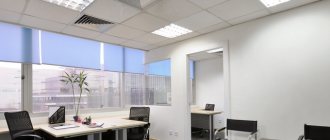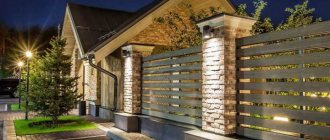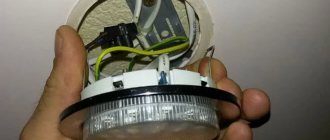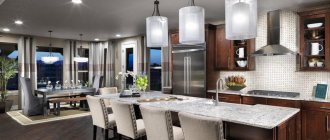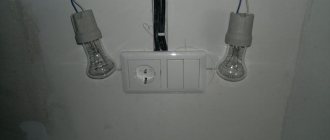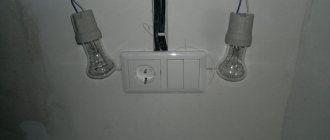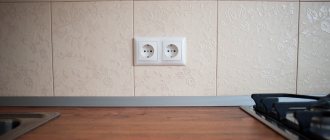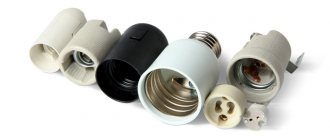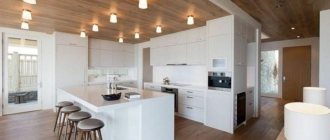The attic is often found both in country houses and in modern urban buildings.
Often an attic in a private house is equipped when the family grows Source dom-elite.com
Many developers try to make full use of the living space they own. Lighting in the attic requires a slightly different approach than for the rest of the premises of a residential building.
We conduct electricity into the attic
The main difficulty is that the space between the wooden elements of the roof structure is usually densely filled with thermal insulation.
Electrical wiring, in turn, has virtually no ability to dissipate heat and, therefore, can heat up, especially from high current. Adding to the difficulties is the fact that there are no clear domestic rules and standards regarding the installation of electrical equipment in under-roof spaces. Therefore, in the process of installing an electrical network in the attic, you should be guided by existing GOST standards and, of course, common sense.
When installing the electrical network in under-roof spaces, you should use:
- for installation of lighting fixtures - copper wires with a cross-section of at least 1.5 sq. mm;
- for installing sockets - copper wires with a cross-section of at least 2.5 sq. mm;
- to protect wiring - fuses with a rated current of 10A;
- to protect sockets - fuses with a rated current of at least 16A.
- The network installation should be carried out avoiding the use of distribution boxes, i.e. each cable must be routed from one power source to one “point”;
- The electrical network must be provided with a separate circuit breaker with a trip setting of 30 mA.
For electrical wiring installed in the attic, it is recommended to use a three-wire cable, or, in extreme cases, three single-wire cables laid in a special protective casing or tube. If necessary, wiring can also be installed using double-insulated wires or multi-core cables.
Note: Electrical wiring laid on a wooden base should never be secured with metal clamps. Such fasteners not only do not provide the recommended distance between the wire and the base, but can also damage the insulation.
Creating a Plan Before you begin installing electrical wiring, you need to accurately consider the future needs of your users. You should create a plan diagram indicating the installation locations of lighting fixtures, sockets, etc. If some “points” are intended to power devices that are too powerful (electric stoves, convector heaters, fan heaters), separate wires must be allocated for them. If you plan to install a water heating boiler in the under-roof room, power to such a unit must be supplied separately.
The number of “points” for lighting fixtures depends on the purpose of each individual room. But the number of sockets can be easily calculated in advance - each electrical appliance requires a separate socket, plus two spare ones.
After counting the required number of “points,” we can begin to determine the amount of cable we need. On average, there is one cable for every 15-20 square meters of living space. Well, there can be much more wires in the under-roof room.
Many sources clearly indicate the maximum number of “points” for one electrical network. Typically this includes 20 lighting fixtures and 10 sockets. But in the attic, lighting fixtures are located at a higher height than in other living spaces. Consequently, for high-quality attic lighting, it is necessary to use more powerful lamps. In this case, to reduce the load on electrical wiring, the following limitation for electrical networks should be accepted: 10 points for lighting fixtures and 6 for sockets.
Cables intended to power particularly powerful devices must terminate in only one connector. This primarily applies to refrigerators, freezers, etc.
Space planning techniques
When planning the attic, the number, size and configuration of the premises are determined, and high-quality roofing and finishing materials are also selected. However, the comfort of life is affected not only by the quality of materials, but also by the layout of the premises.
Techniques have been developed to help optimally distribute space. When planning rooms, the following tips will be useful:
The bed in the bedroom is placed under an inclined surface, this will help make the most of the space. The sleeping place can be placed along an inclined wall or with the head of it facing it. The last option is less dangerous, since you don’t have to worry about your head.
Compact distribution of sleeping placesSource hzcdn.com
The most convenient place for bulky furniture is at the highest wall
It is beneficial to make some items to order - they will fit perfectly into the chosen location and save space. In the bathroom, it is important to choose the right place to install the plumbing. At the place where the sink is installed, the height of the attic should be at least 1.5 m, at the place where the toilet is installed - at least 0.9-1 m.
Original bedroom designSource pinimg.com
About the intricacies of the attic floor layout in the following video:
Types of lighting fixtures for the attic
The attic space can be filled with light using one or more sources. General lighting is provided by a chandelier with several bulbs. Local lighting devices are especially popular when lighting such premises. They come in several types.
- Sconces, wall lamps, portable lamps.
- Spots for ceilings and walls. These are directional lighting fixtures that are located on a bracket. They can be rotated in different directions and brightness adjusted.
- Floor lamps. Their ideal place is near an armchair or sofa.
- Point light sources: they are used both independently and as additional lighting. Indispensable for a small area of space. Installed in plasterboard and suspended ceilings.
- Crystal light diffusers. They favorably emphasize decorative elements. The different sizes of the refracted elements of the lamp create the effect of crystal reflections.
- LED lighting for the attic. With its help, you can organize lighting for mirrors, shelves, beds, and the perimeter of the ceiling. It is a special tape that can be single-color or multi-color.
- Fiber optic threads. They consist of a stationary storage source and lighting fibers. With their help you can decorate the starry sky and other design solutions.
- Fluorescent lamps. They are installed in a suspended or plasterboard ceiling and create the effect of scattering light rays along the perimeter of the ceiling. This is an option that saves electricity.
You can combine several local lighting devices with the main light source. For example, installing a chandelier in the attic in the center and spotlights along the perimeter of the ceiling will make the room evenly illuminated over the entire area.
How are lamps installed?
It is better to choose lighting before installing the stretch ceiling in order to get rid of difficulties in the future: install the required number and types of mortgages, install a hook of the required length under the chandelier in advance, if necessary. And also plan the required installation depth in case of installing recessed spotlights.
Plank and mortgage
Most ceiling lamps - chandeliers, wall-ceiling lamps, rotating spotlights, overhead spotlights - have a fastening (holes in the base of the lamp itself or a mounting strip inside the base), which, in turn, is screwed to the mounting platform.
Fastenings for different types of lamps
Mortgage
necessary, since the thickness of the suspended ceiling covering is only a few millimeters, and it will not be possible to attach lighting fixtures to it. The mortgage consists of a platform, which is located under the tension fabric and is attached directly to the concrete ceiling using metal hangers with dowels. You can buy a ready-made platform in a store or make it yourself - for example, from wooden blocks.
Types of mortgages
The main stages of installing the plank to the mortgage:
- the required type of mortgage is prepared in advance and mounted to the concrete ceiling;
- the ceiling fabric is stretched;
- A hole for attaching the lamp is marked and a protective thermal ring is glued. Its outer diameter should be slightly smaller than the decorative base of the chandelier or lamp, otherwise the thermal ring will be visible after installation;
- a hole is cut in the tension fabric inside the thermal ring;
- electrical wires are pulled out and connected;
- The lamp mount is screwed to the mortgage.
Built-in installation
In the case of recessed spotlights, the principle remains the same. Only in this case, the lamps have fastening “claws”, which are inserted into a special mounting for recessed lamps with a hole in the center. On sale there are round and square platforms for a fixed size mortgage, as well as universal platforms, inside of which you independently cut a hole of the required diameter.
Loop and hook
Some chandeliers
designed for hanging on a hook
, pre-installed into the concrete ceiling, so they are fastened in the form of a loop on the reinforcement.
Chandelier with hook mount
Main stages of installation on a hook:
- the hook is pre-mounted to the concrete ceiling;
- The ceiling fabric is stretched. The lower part of the ceiling hook should be located 3-4 mm above the surface of the tension fabric so that the decorative base of the lamp fits closely to it. If necessary, the hook can be extended using a chain, and a new hook at the end is made of thick wire bent in the shape of the letter “S”;
- A hole for attaching the lamp is marked and a protective thermal ring is glued. Its outer diameter should be slightly smaller than the decorative base of the chandelier, otherwise the thermal ring will be visible after installation;
- a hole is cut in the tension fabric inside the thermal ring;
- electrical wires are pulled out and connected;
- The chandelier itself is hung on a hook.
How to replace the lamp?
Chandelier replacement
If you choose a chandelier for a pre-prepared hole, you need to measure its diameter. The mount for the new chandelier or light fixture must fit into this hole, and the base must be of a diameter large enough to cover it.
How to determine the required hole for a chandelier?
Measure the center-to-center distance (the distance between the holes in the mounting strip): it should be smaller than the hole in the ceiling.
If the hole is too small, then make additional cavities in the chandelier mounting strip.
Replacing spotlights
In the case of a suspended ceiling, you can replace spotlights yourself only if the new lamp has exactly the same shape and size as the old one. This guarantees full compliance with the already installed mortgage for the model of the new lamp.
To make a replacement, you need to carefully pry the decorative rim of the lamp and pull it towards you. That is, remove it from the mortgage and then disconnect the wires.
Installing a new lamp is also simple: first you need to connect the wires to the terminal block, observing the polarity. Then clamp the “legs” and insert the lamp into the platform.
Lighting devices in the attic
Depending on the principle of light supply, lamps can be local or general. The first group includes the following lighting options:
- Sconces and wall lamps.
- Floor lamps.
- Portable sources for tables and cabinets.
- Local devices.
The second group consists of those devices that can be used in any other rooms of the house, and not just in the attic. These include ceiling chandeliers with different intensities and operating power.
When choosing lighting for the attic, you need to familiarize yourself with the features of all types that are available for sale:
- Local lamps. They belong to the group of local lighting devices capable of directing the flow of light to individual zones. Among them: wall sconces, table lamps and floor lamps. This type allows you to focus on interior features and emphasize the harmony of style.
- Crystal diffuser. It works based on the play of light and shadow, providing an original star effect on walls or ceilings.
- Point universal developments that can be used separately or combined with other elements of the system.
- LED Strip Light. It is a common type of lighting system that can be used for interior decoration.
- Neon elements. Suitable for use with universal devices and diode strips. Solid and rainbow types are available for sale.
Neon lighting is in particular demand, which has the following advantages:
- Safety for the human body and the environment.
- Invulnerable to explosions or fires.
- Uniform light distribution. Neon lighting provides a soft lighting effect.
- Long service life. Products can operate without failures for 10 years.
- No noise during operation.
- Low heat during operation.
The disadvantages include a number of difficulties in self-production, which is why the work must be carried out by a trained specialist.
Sources of light
First you need to remember that there is general and local artificial lighting. In the general version, light is evenly distributed from one source throughout the room; most often in this case a chandelier or other ceiling lamps are used. As for the local type, the emphasis is on a specific area of the attic. A variety of sconces, spots, floor lamps, table lamps or even floor lamps - all this applies to this type of lighting. You can, according to your taste, focus on any details and things of the interior (for example, paintings, cabinets or shelves with books). Here you can show your imagination to the fullest, the main thing is not to overdo it!
Often in private houses, the ceiling in the attic is sloping due to the roof and is equipped with wooden floor beams. If this is your attic option, avoid general lighting altogether, this will visually reduce the space. The same applies to low ceilings (unless you can install an LED strip, a feeling of celebration and comfort is guaranteed). If you are the happy owner of a spacious attic floor with high ceilings, here you can either give preference to one light source or make a combined option.
For inspiration, we recommend looking at our photo gallery of beautiful attic lighting:
Attic lighting options
Electrical communications are planned at the stage of creating a house project; only minor adjustments may appear when choosing the decorative design of the space. For a competent solution, there are several options for lighting the attic and depends entirely on the presence and size of windows, as well as the intended division of space into zones and design style.
Zoning of the attic space depends on the desire of the owners to use the floor for its intended purpose. Before choosing lamps, you need to decide on the purpose of the space, then choose a style solution and color preferences. During preliminary planning, it is worthwhile to outline the approximate location of artificial light sources.
Let's decide on the purpose and options for using the attic:
- for work, when the space is used as an office, library or art workshop;
- for relaxation, if you plan to arrange a bedroom or guest room, for example, if adult children come only for the holidays; a home theater can also be placed with maximum comfort;
- as a play area, when it is planned to place play modules for children, a sports corner or, say, a tennis table on the floor;
- for sleeping, since quite often the owners arrange a bedroom on the top floor;
Lighting for a nursery in the attic.
Each option has its own advantages and a narrow spectrum when choosing lighting, the devices themselves, the power of the lamps and their location in space. An individual project assumes the opportunity to show taste and the ability to create the most comfortable interior possible for the owners of the house. Careful planning will allow you to install electrical equipment thoughtfully and discreetly from prying eyes.
In general, electricity itself, and in particular in the attic, poses a threat to the fire safety of the house, therefore the selection and laying of communications, installation of a machine and other work must be carried out in compliance with safety standards and technical conditions.
But you shouldn’t get carried away with decorative techniques, since there are general rules, following which you can complete several tasks at once. Let's consider the main options and features of attic lighting today:
- local lamps – designed for locally located points of directional light. These include sconces, floor lamps or table lamps, thanks to which the lighting is concentrated in the necessary areas; allows you to read, knit or highlight a zone in the general interior;
- overhead lighting - can be presented in the form of one or more light sources located on the ceiling. This type includes all types of ceiling chandeliers or groups of overhead lamps; this source provides diffused general light, which is necessary, especially if your attic has no windows or has one small one;
- spotlights - this type is used as an additional source of electric light. Spot light can be located on the ceiling, in corners, on walls and plays a rather decorative role;
- LED strip - on the attic floor can highlight special architectural details of the space with light. Custom windows, roof configurations or mirrors stand out perfectly thanks to the LED strip.
Using LED strip for attic lighting.
Features of lighting depending on the ceiling design
Relatively small houses of 2-3 floors are usually built from logs, timber and other wood. It is not always possible to make the ceilings high; sometimes beams become part of the ceiling; often the attic floor is also made residential. In all these cases there are nuances regarding the lighting system.
When the ceiling is low
Choosing a lighting fixture for a room with a low ceiling is not so easy. Sometimes it can look untidy or even get in the way, especially for tall residents. Therefore, hanging chandeliers are not suitable.
Overhead lamps are suitable for low ceilings.
For houses with low ceilings the following are suitable:
- Horizontal type chandeliers. Lamps with several shades that are located at a distance of 10-20 cm from the ceiling. You can use options with translucent shades aimed at the ceiling, this helps diffuse the light.
- Built-in and surface-mounted lamps. A system of overhead chandeliers can serve as the basis for lighting a room with a low ceiling. Additionally, certain areas can be illuminated with built-in lamps.
With wooden beams
In such rooms, there is no point in fixing chandeliers on the main ceiling; the light source will be very high, and a shadow will be cast from the beams. Therefore, the lamps are mounted either in the beams themselves or in the ceiling (if there is one).
Point light sources look great in the ceiling.
Spot or small overhead lights are usually installed in the ceiling. Such devices weigh little, so they will not create a high load on the materials. The beams themselves are a more durable structure, so they are suitable for overhead lamps and chandeliers. If there is no ceiling, you can simply install a lot of loft-style pendant lamps.
Project with pendant lamps on beams.
Beams can also become one of the main design elements. In non-residential premises, for example, in a corridor, you can install wall lamps, and attach LED strips to the surface of the beams, the light from which is directed upward, it will be scattered. In other rooms, this type of lighting can only be decorative, additional.
Beam lighting.
Mansard type
Correctly selected lighting for the attic in a wooden house can influence the comfort
When choosing lamps, it is important to consider the dimensions and shape of the floor. The number of windows also plays a role, affecting the level of natural light.
What is used on the attic floors:
- Local lamps that illuminate certain parts of the room. Focusing on certain details contributes well to the overall appearance of the room. For this purpose, wall and table lamps and floor lamps are used.
- Light diffuser. Such a device is usually made of crystal; thanks to the play of light and shadows, it recreates unique patterns - stars, snow, etc.
- Spotlights. The most popular option for attic lighting. Spot light sources are suitable even for areas with the lowest ceiling levels.
- LED Strip Light. Its advantage is that it does not take up extra space. The tape can be used to provide illumination along the contour, or to arrange lamps by folding the strips into certain shapes (rectangle, square, etc.).
- Neon lights. Used as a supplement to main lighting. It can be either monochromatic, in the same color temperature as the lamps, or with changing colors.
Choosing lamps for the attic
In order to properly organize the lighting of the attic floor in a private house, it is recommended to pay attention to the choice of lighting fixtures. The high quality of the lamp contributes to the complete creation of a working environment under the roof
To select lamps for installation in the attic floor, consider the following factors:
- The area should have as much light as possible. The rules apply as much as possible to daylight hours, so you need to install upper windows. To increase the amount of light, you can install a large mirror opposite them.
- For the attic it is better to choose a light design, as in the photo
For it, select light lamps - preferably with a white or light shade of light. This way you will visually expand the space. When choosing a floor lamp, it is better to choose a floor lamp with a high leg. It is recommended to install them in the corners of the room to visually enlarge the attic floor. To create a work environment, install cool lighting. For this purpose, fluorescent lamps are installed. To create a semblance of natural daylight, you can install tungsten-halogen light bulbs; they will help create a cozy atmosphere on the attic floor.
Consider the difference between local lighting for the attic floor and full lighting. The first cannot completely illuminate the space so that it can be actively used at night or in the evening, when natural light will not enter the room.
What else do you need to know
We have prepared for you some additional tips that will help you make the attic your favorite place in the house:
- The attic floor should be bright; take this into account not only when installing lighting, but also when selecting finishes and furniture.
- To visually increase the space, add lighting in a large floor mirror and place it opposite the window.
- If you want to make electric lighting in the attic similar to natural, use halogen lamps. A fluorescent lamp will provide cooler light.
- To blur the boundaries of the room, install a strip with built-in lamps, which should be directed towards the wall.
- Don’t forget about the quality of the devices you buy; this is an important indicator of durability and your peace of mind.
We also recommend that you watch the video of a modern method that allows you to make attic lighting cozy:
So, we told you how to make beautiful lighting in the attic, providing photo ideas for inspiration. The attic has long ceased to be a place for storing unnecessary things and can become a full-fledged place for relaxation. Many modern families even make a children's room or bedroom on the attic floor. It doesn’t matter whether you are furnishing a room in a country house or a huge country house, the main thing is to correctly place the accents and take care of comfort.
Selection of lighting fixtures
When choosing lamps and fixtures for the attic, you need to adhere to the following rules and recommendations:
In this part of the house, only high-quality appliances should be installed, and their quantity should be large. Many designers recommend additional lighting for furniture and walls. To make the attic presentable and stylish, the light should be directed towards the wall. This solution will create a feeling of visual expansion of the space. You can make the attic floor more spacious by placing lamps around the perimeter. You should also install a mirror surface in the room. LED and halogen lamps are suitable for attic lighting. In terms of lighting efficiency, they are not inferior to each other, but give a different glow. When choosing lamps, the individual preferences of the residents of the house are taken into account. The style of the appliances is selected taking into account the decorative features
The main thing is that they combine with each other and look harmonious. When determining the optimal light output, it is important to exclude street lights, since they turn off at night.
It is inconvenient to use spotlights for the attic floor, since the light from them is scattered unevenly. It is better to combine several different devices, placing local devices around the perimeter, and a large chandelier in the central part.
To emphasize the special style and harmony of the interior, a pair of floor lamps are installed at corner points.
Briefly about the main thing
Most popular projects of private houses have an attic floor, which is not surprising, given the cost-effectiveness and originality of such a structural element.
Mansard roofs differ in their design, which also affects the characteristics of the rooms located underneath them. The attic floor can be turned into full-fledged housing if you follow construction standards, insulate the walls and protect them from moisture, provide ventilation and take care of sufficient lighting. Comfort of living and arrangement possibilities also depend on the height of the attic walls and methods of space planning.
For houses of different sizes, there are optimal options for planning and arranging the attic; these include ways to arrange furniture and the ability to make custom pieces.
Attic lighting for different styles
Lighting the attic will help enhance the atmosphere of the overall style of the room. The play of light using the refraction of rays can be created using mirrors, glass and other reflective surfaces. Chandelier bottles, floor lamps and lamps should be chosen in accordance with the color scheme of the room or used to create bright contrasts.
Classic attic style
If the attic is decorated in an antique or classic style, then a chandelier suspended in the center of the beam will become a bright accent. Such lighting will help enhance the effect of high cost from the presence of antiques in the interior of the room.
Modern design trends for the attic
- If the attic is decorated in Art Nouveau style, then fluorescent light sources built into the suspended ceiling will be a successful addition. You can also use spotlights, which can have rotating and stationary designs.
- When installing stationary lighting fixtures, you must immediately determine the optimal direction of the light rays. Spot rotators allow you to change the direction of the light if necessary.
- Glass and metal elements in the design of the attic will also successfully highlight modern trends in high-tech style and create glare when lighting is directed in their direction.
Eastern attic style
- The romantic setting of an attic in an oriental style should be accompanied by very delicate and subdued lighting. It can be made in the style of openwork lanterns hung on the walls, carved floor lamps, as well as massive elegant chandeliers, if the space of the room allows.
- To decide on the type of chandelier in the attic and create a successful combination of light and room furnishings, check out the photos of various design solutions for the interior of the attic.
- Local lighting sources visually expand the space of the room. Sconces, table lamps and floor lamps put bright accents on pieces of furniture and decor and add completeness to the interior.
Standard solutions for ceiling and lighting layouts
The problem of providing the attic with light can be solved in two ways. In the first case, the owners almost completely abandon window openings on inclined walls and, accordingly, provide most of the light needs through lamps and lighting devices. Lamps for the attic are incredibly important, but, as practice shows, this is not enough for full-fledged living.
It is necessary to add windows to the lamps on the ceiling
Therefore, most designers choose the second path. When planning attic lighting, use all available means:
- Installation of windows, both on gables and on sloping walls of the room;
- The use of vertical partitions in the room to improve the reflection of light in the direction of inclined walls;
- Widespread use of spotlights, directional and strip lights;
- Painting the walls and ceiling of the attic in light colors.
In addition, in the interior of the attic there may be no ceilings at all, which improves ventilation and the air exchange rate in the room. In this case, directional lamps have to be installed on the cross beams at ceiling level, photo.
Lanterns in the beams under the ceiling make the attic lighting more uniform
Proper use of window openings
In most cases, attic ceilings, photo, due to their specific design, do not allow the installation of a horizontal transparent hatch or window; accordingly, most of the daylight can only enter through window openings installed in inclined walls.
Windows in the attic can be on the wall and on the pediment at the same time
Ideally, with such a layout, window openings should be raised to the maximum height, usually this is the upper third of the wall adjacent to the ceiling. For a small bedroom or any similar attic room, this will be enough; you just need to add spotlights on the ceiling, and the lighting problem will be solved.
In addition to daylight, you have to add spotlights on the ceiling
Often it is simply not technically possible to free up enough space on sloping walls for two windows. In this case, the window opening is made with raster-type slopes, as in the photo.
Raster slopes of a window opening
This scheme has been known since the Middle Ages; opening the slopes provides an increase in light flux by almost 50%. For evening illumination of the attic, spotlights and pendant lamps are used on the ceiling of the room.
Sometimes windows can be installed very low, almost above the floor. This layout is dictated by the oriental style of the attic, so you have to use a full-fledged chandelier mounted on the ceiling and directional LED lights.
Chandelier on the ceiling and lanterns on the slanted walls
Most of the light enters the room through the window on the gable
This arrangement will be especially advantageous if the ceiling and sloping walls of the attic are finished with natural wood material.
A row of windows occupying the entire plane of the inclined wall completely provides the attic with light.
Location of lamps in the interior of the attic
Classic pendant or rack lighting devices are rarely used for attic floors. Most often, a chandelier or multi-arm sconce is used as a decorative element of the same ceiling.
Lamps, usually directional or strip, are used as a complement to daylight, so they are installed in two versions:
- As illumination of a ceiling or ceiling area. Lanterns are mounted on horizontal beams or in the upper part of inclined walls adjacent to the ceiling;
- For illuminating large or extremely dark rooms. Due to the small size of the windows, there is not enough daylight, so it would be appropriate to use LED strips.
There are also original models of lamps made in the form of transparent screens that imitate windows with a blurred, uneven surface. The result is the effect of a landscape outside the window, and thanks to the use of built-in fluorescent lamps, the lighting quality is ideal. It is clear that this style of attic interior is a strictly individual, one-piece product that is not suitable for everyone, so there is no point in blindly copying solutions.
Lighting for a sloping attic
Spot lamps.
The rules for selecting and placing devices in rooms with a sloping ceiling and in other rooms are similar. Regardless of the number of windows, sunlight enters the rooms only during the day.
After dusk, artificial lighting is turned on. Standard ceiling chandeliers are not suitable: they will look ugly on a sloping ceiling.
In addition, the devices take up useful space, which is a disadvantage for a room of small height. When arranging attic lighting, the following points are taken into account:
With small window sizes, the room will be dark even during the day. In this case, a larger number of lamps are installed. For a room with a sloping ceiling, choose hanging fixtures. The installation of mortise devices should be abandoned. Spot and local lamps must fit into the interior of the attic
You need to pay attention to the shape of the lamp, giving preference to curved products. The power of the devices is selected taking into account the material from which the ceiling is made. This rule applies only when choosing built-in models.
Features of the attic floor
The attic space on the top floor of a building, directly under the roof, is called an attic. At first it had no practical value, but in the 17th century it began to be used as living quarters, which is still considered a good idea today.
The main feature of the attic is the sloping ceiling located at an angle to the walls. It can slope only on one side, be gable or broken, mercilessly cutting off the space of the room. The walls of such a room are usually low, which, in tandem with a sloping ceiling, can “put pressure” on perception.
To prevent the room from being depressing, you need to take care of good natural lighting in the attic. In this case, windows can be installed not only in the walls, but also on the ceiling, which allows more light to penetrate. There is no way without artificial lighting either. Even if you only use the room during the day, it will be very useful in cloudy weather. Lamps and lamps not only make the room brighter, but also help solve various interior problems - expand it, make it more romantic, or turn it into a full-fledged work area.
Nuances of lighting organization
Before starting installation, it is necessary to plan the layout and power of the devices
In this case, they take into account the shape and height of the room, the angle of the roof, etc.
But they do not take into account the sun's rays, because in the dark there will be none. In addition, windows located on the walls are partially obscured by the roof.
It is advisable to provide different lighting scenarios. Typically, a chandelier is used for this as the main light source and several additional or two or three groups of lamps. The devices are connected to different switches. Using everything together or separately, you get a cheerful, work or romantic atmosphere.
The function of the attic is also taken into account. You don’t need a lot of light in the bedroom, but it’s worth highlighting brighter areas around the bed and closet.
You will need more of it in your office, especially above your desk. Here you need to screw in bright light bulbs that will protect your eyes from unnecessary fatigue.
In the nursery you will need general lighting, additional lighting near the desk, and a dim night light near the bed. Interesting ideas are often chosen, for example, sconces in the shape of the sun or moon or a “starry sky” stretch ceiling.
It is also necessary to take into account finishing materials. White and pastel colors, especially on glossy surfaces, reflect light. And the matte texture and dark shades are absorbing. To compensate for the effect, more powerful lamps will be needed.
Lighting can help improve the layout of your attic. If you arrange the devices so that the rays are directed at the ceiling, it will seem higher. And to expand the room, the walls are illuminated. This will be helped by sconces and other sources located around the perimeter.
LED strips are also used, which are placed along the walls, on the border of functional areas, on beams, etc. Not only white ones are available for sale, but also colored ones, including ones that change shade. This will diversify the environment.
Less often they take neon elements, plain or rainbow. This backlight does not heat up, does not make noise during operation and is durable. But it is not easy to install it; it is better to invite a specialist.
It is important to comply with safety requirements, especially if the attic has a wooden finish:
- take a three-core cable;
- do not attach wires directly to unprotected surfaces (use protective covers and boxes);
- Do not place a distribution board in the attic.
It is advisable to think through the location of all electrical appliances in advance. Then, during the repair, a sufficient number of sockets are installed. And the wires are laid in such a way that it is safe and aesthetically pleasing.
Purpose of stage lighting
Stage lighting is very powerful; it is artificial light, which plays a leading role not only in the theater, cultural center, but also on the stage of the school assembly hall. All parameters are implemented using lamps, spotlights and spotlights. The main factor in the quality of lighting is the angle of the directional flow of light. Some rules are important for the stage lighting process:
lighting is a part of the action that emphasizes the key events of the performance and controls the attention of people sitting in the hall;
the layout of lighting equipment depends on the direction of a particular event and is carefully planned in advance;
the amount of equipment is chosen according to the task at hand and the size of the specific stage. For large areas, multi-level lighting structures are installed; for the event, the director and set designer develop the influence of light on the action; work out several options in advance;
Illumination standards or how much light a person needs
Quite often a person feels psychologically a lack of sunlight, especially in regions where the lack of sun is significant due to natural conditions. Artificial lighting is designed to fill this gap to normal. The concept of a norm in this case is vague, but it has been scientifically proven that a person must be in light, even if artificial, for approximately 9-10 hours a day.
Calculations of the norm of natural lighting are measured in lux units, for example, in sunny weather the measurements are 100,000 Lux, and indoors, even near a window it will be a little more than 100 Lux, which immediately indicates insufficiency for plants and humans.
Types of lighting and its regulation depend on the type of premises. The calculation method, its sanitary standards range from 150-200Lx for common rooms, such as the kitchen, living room, bathroom.
For corridors, hallways, bedrooms or balconies the norm will be below 100Lx. But work areas in the kitchen, at the desk, and for reading should be additionally equipped with artificial light lamps.
It is believed that non-residential premises such as offices, gyms and manufacturing workshops maintain artificial lighting at a level of 200 to 300 lux to encourage people to be active.
Artificial lighting.
How to calculate how many lamps you need?
Before choosing a layout, be sure to calculate the optimal number of lamps. To do this, you can use one of 3 methods:
A formula according to which the product of the illumination standard (according to SNiP for most residential premises the indicator is 150 Lux), the area of the room (in square meters) and the ceiling height coefficient is divided by the luminous flux of a spotlight (measured in lumens, you can look at the packaging or find a suitable one table on the Internet). Ceiling height coefficient in the apartment:
| Height | Index |
| Up to 2.7 m | 1 |
| 2.7-3 m | 1,2 |
| 3-3.5 m | 1,5 |
| 3.5-4.5 m | 2 |
- An online calculator in which all the formulas are already included - all you have to do is enter your individual data and get a quick answer. The disadvantages of this solution include inaccurate calculation: different sites show different indicators, depending on what formula is used.
- The easiest way is to use ready-made recommendations. But it should be taken into account that they were developed for standard spotlights and are suitable only for ceilings of 2.6-2.8 m. Experts advise purchasing lighting at the rate of 5 W (LED power) per 1 m². That is, in a space of 10 m2 you will need to place lamps with a total power of 50 W - 9 x 6 W, 7 x 8 W or 5 x 10 W.
A separate point should be made about the calculation in case of adding a chandelier. Usually it is responsible for bright light, and spotlights are additional. To calculate how many light bulbs are needed, let’s improve the formula. We should proceed from the same indicator - 5 W per 1 m², but the resulting figure must be divided by 2. That is, in a room of 10 m², a chandelier should produce 25 W and 25 W point sources (4 x 6 W, for example).
Important! You can round the data obtained from the formula in any direction - but it is better to take one lamp more. So, if 1-2 points fail, the room will not remain in twilight
Wooden attic lighting
In our country, the favorite material for interior decoration is wood. The attic will not be an exception, especially when the rustic style, Provence and any inclusion of ethnic details are in fashion. The lighting style in this case should correspond to the overall design, and the shape of the lamps should be in harmony with the wooden walls. Let's talk in more detail about the types of lamps for these styles:
Original chandelier for the attic in a rustic style.
A rustic-style attic may be the best option for arranging a cottage attic. It may just seem that this style is simple. Lamps attached to or behind ceiling beams will look original, creating the effect of dim lighting. Each wooden element can be illuminated locally to highlight the beauty and naturalness of natural wood.
The presence of an attic implies that the space of the house will be used as usefully as possible. Before choosing the shape and type of lamps, look through photos of finished interiors, draw up an approximate project in the desired style and color. If you find it difficult to choose, you can always contact specialists who will help you make a choice and install lighting wiring.
Nuances of electrical wiring for the attic area
Properly installed wiring is the key to long and reliable operation. Regardless of the main material of the walls, the attic space can be made of wood or lined with clapboard. In addition, there is an impressive thermal insulation layer made of artificial materials, which can contribute to overheating of the cables and creates a risk of fire.
For high-quality and safe wiring, three-core wires are used, hidden in special boxes or casings. All cables must come from a common panel.
Lighting of the office on the attic floor
The attic, equipped as a study, should have a high level of illumination. This can be achieved thanks to several levels of light, one of which will definitely be located near the desktop.
Lighting for the leisure area in the attic
- Many families use the attic space to spend time together. A home theater is often installed here. To ensure that watching movies only brings pleasant sensations, the attic windows should be closed from daylight using blinds made of dark-colored fabric.
- The cinema area looks good in the lighting of laconic spotlights.
- A gym can be equipped on the attic floor. In this case, it is correct to install 2 light sources: central and side. Additional lighting should be placed near the mirror, then in its reflection you will clearly see your actions.
Additional lighting devices
They are installed in a corner for reading, handicrafts, when light accents and highlighting of bright interior items are needed - for example, paintings, stucco moldings, decorations, etc. These are:
- Wall lights. They can be built-in or overhead (sconces), in design - armature, wall-mounted (used in a narrow space, as a backlight for pictures), stationary, adjustable, with a reflected and directed beam. When the main lighting is turned off, sconces create a cozy atmosphere; they are installed near the reading chair to emphasize the interesting texture and stucco molding. Wall sconces in the work area replace a table lamp. When placing sconces, you need to make sure that they do not interfere with the passage.
- Floor lamps. This is the common name for a floor lamp. Typically, such a device has a leg (straight, curved, or even adjustable in height or offset). Thanks to the lampshade and diffuser, the device produces dim, diffused light. The beam is directed up or down, in both directions. But the cap is an optional attribute; models are produced without this detail. Floor lamps can be stationary or portable, with one or more lamps.
- Bottom lighting. Floor-recessed lamps are still rarely used, although they look very impressive, especially in recreation rooms. They are usually built into podiums - like ceiling “points”.
- Desk lamp. They are also placed on the fireplace, bedside tables, near the sofa if they are working on it, etc.
- Optical fiber. This light source is economical and, most importantly, safer than its analogues. It can be used even in damp areas. Optical fiber emits light in transverse and lateral projection. This allows you to create a variety of compositions - for example, the popular “starry sky”. The fiber is cut even when it is turned on - no current is transmitted through it. Although the material is used for the main lighting, its task is still auxiliary lighting.
Options for placing lamps in the attic room
There are a number of options and layouts for placing lamps on the attic floor. However, the most commonly practiced solutions are:
- Suspended design. It is not advisable to use classic appliances with a rigid leg in the attic and hang them on a sloping surface. It is better to purchase a lamp with a flexible, adjustable suspension and fix it so that the lampshade is directed parallel to the floor. In attics with a triangle-shaped ceiling, chandeliers with elongated pendants are used, and the ceiling in the attic should be high.
- Fixation to a flat part. This method is effective in cases where one section of the attic is made in a beveled shape and has a small horizontal area directed parallel to the floor. As for suspended ceilings, the chandelier is fixed in them in the same way as in other rooms. However, if the flat surface is located at a great distance from the center, then it will not be possible to obtain a uniform distribution of light. You will need to use secondary devices or use local light sources.
- Beam mounting. In the area of the ceilings of many attic floors there are beams that are located in the central part of the roof and have 2 slopes. If the height of the building is large enough, then a simple chandelier can be attached to such beams.
Guided by simple rules and recommendations for lighting design, you can create a beautiful and elegant attic that will receive a sufficient amount of light, both from windows and lamps.
https://youtube.com/watch?v=jTbD-vYy0XY
SNIP requirements
According to the rules of SNiP 2.08.01-89, the top point of the ceiling of the attic floor must be more than 2.5 m. Also, the owner of the house must take into account that the low location of the horizontal ties interferes with the equipment of the residential unit, and from the attic floor to the joining line of the slopes and walls there must be not less than 1.5 m.
A ventilation and communication system must be installed inside the premises. It is also necessary to make lighting that provides sufficient natural light to the attic floor.
Any attic floor is subject to heat loss, so for reasons of economy, effective thermal insulation is necessary. The roof structure of the building in which the attic is planned must be strong enough.
In this case, it will be able to withstand additional load as insulation and an insulating layer. During construction and repair work, the attic walls must be treated with a special fire-resistant compound.
Species and types
To choose lamps for the attic, first pay attention to their classification. You can match your original preferences and organize a small space as in the photo
However, keep in mind that in the photo the area may be visually enlarged.
The quality of lighting depends on the type of lamps installed. For a relaxation area, for example, you need to use dim lighting, and for an active work area, vice versa.
Standardly, all lamps regarding the method of their installation and placement on the floor are:
- Local. They are installed locally, without connecting to each other. These include individual floor lamps, sconces and other spotlights. They are especially often used after the construction of the house, so as not to resume deep work with electrical wiring.
- Full. They apply to the entire house and are planned in advance. For the attic, chandeliers transform the floor into a full-fledged work and living attic space that is comfortable to use at any time. However, it is not always possible to attach chandeliers in the attic, which is why the first option is used.
Locals come in different types, since the way they are attached differs:
- Floor-standing. A simple option that can be conveniently rearranged for zoning the attic floor.
- Wall-mounted. You can attach the lights to the wall, which is more often used for a work or reading area.
- Built-in. The set can be equipped with lanterns that will create a multi-level lighting system for the room.
The type is selected based on the preferences of the residents regarding the use of the attic area. To do this, you can look at photo examples of installing lighting fixtures so that they match the interior of the house and correspond to the functionality.
Briefly about the main thing
Most popular projects of private houses have an attic floor, which is not surprising, given the cost-effectiveness and originality of such a structural element. Mansard roofs differ in their design, which also affects the characteristics of the rooms located underneath them.
The attic floor can be turned into full-fledged housing if you follow construction standards, insulate the walls and protect them from moisture, provide ventilation and take care of sufficient lighting. Comfort of living and arrangement possibilities also depend on the height of the attic walls and methods of space planning.
For houses of different sizes, there are optimal options for planning and arranging the attic; these include ways to arrange furniture and the ability to make custom pieces.
Review of popular manufacturers
The range of spotlights on the market is quite wide. Dozens of factories present their products. Let's look at the most famous ones.
Ecola
A company from China presents unique lamps that use about 7% of electricity compared to conventional incandescent devices. The service life of the products is 5-10 years.
Ecola specializes in luminaires for suspended ceilings, including the GX53 with a thickness of 27 mm. The H4 model of this type is available in nine colors. One of its advantages is the metal eyelet to which the spring is connected. In the similar H6 model, everything is made of plastic. This material ages, so over time the fasteners break and the lamp is held in the air only by the electrical wiring. The company also produces reflex devices. One of the unique new products is a lamp with a key, which cannot be unscrewed from the base without authorization.
Philips
The Dutch company has also succeeded in this field, having founded the Signify trademark. Under this name, universal and reliable lighting devices are produced. Many are compatible with suspended ceilings - for example, Probos spotlights. One of the distinctive features of the Signify brand is its stylish European design, which gives the interior a special charm.
Gauss
Spotlights from this brand are made in Germany, a country that is famous for its scrupulousness, punctuality and accuracy. There are solutions for different interiors. Thus, the discreet Aluminum and Tablet lines will fit perfectly into the high-tech style. Gypsum are designed more for the “classics”. Brilliance and Crystal products create interesting reflections on a glossy surface.
Citilux
The Danish brand, founded in 1944, creates household lighting “for a beautiful and comfortable life.” Its products are recognizable by their ease of use, light and elegant design, characteristic of the Scandinavian style. The devices are resistant to moisture, temperature fluctuations, and vibrations. The main part of the range is presented in an affordable price category. For suspended ceilings, Citilux produces lines of spotlights “Alpha”, “Beta” and “Luna”.
Feron
This is another Chinese manufacturer on the Russian market. There is also plenty to choose from. Almost all types of spotlights are manufactured for suspended ceilings - LED, waterproof, crystal, built-in, overhead, etc. The brand presents its products in the budget price category.
Navigator
The plant, located in Klin, Moscow region, is equipped with the latest technology. Advanced technologies have been introduced into production, allowing us to produce products that can be put on par with imported analogues. The brand offers modern devices - LED panels, built-in and surface-mounted spots and lamps.
